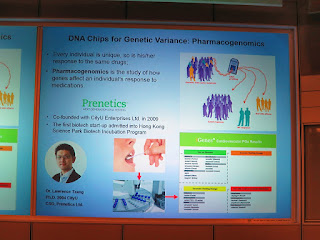The CityU President's Lecture
Series is Excellence in Academia which offers a platform for scholars to reach
out to students and faculty across the CityU community, bringing together
scientists, engineers, economists, lawyers, sociologists and creative media
exponents, to name but a few, to discuss wide-ranging academic investigations. The lecture topic named “Biochips and
Nanomedicine: From Basic Research to Clinical Applications” was held on 29 Jan
2016. It aimed to introduce the brief history
of DNA and biotechnology, and present research on biochip technology and
nanotechnology and their applications for disease diagnosis and therapy, with
examples including DNA chips for early screening of cervical cancer,
microfluidics for understanding tumor growth and metastasis, and precision
nanomedicine for treatment of cancer.
Before the seminar, I took a photo with speaker and professors for
memory.
(Left: I, Prof. Michael Yang
Mengsu (BMS), Dr. F.W. Lee (BCH) and Prof. Shuk Han Cheng (BMS)
In the beginning, Prof. Paul Lam
(Vice-President, Chair Professor, BCH) gave opening speech and introduced today’s
speaker Prof. Michael Yang Mengsu.
Prof. Michael Yang Mengsu (Head and Chair Professor, Department of Biomedical Sciences, CityU) briefed the seminar outline included “A brief history of DNA & Biotech”, “DNA Chips for Cancer Screening”, “Tumor on a Chip” and “Nanomedicine for Cancer Treatment”.
A Brief History of DNA was showed
as follows.
Molecular Structure of Nucleic Acids
-
1962 Nobel Prize in Physicology/Medicine – Francis Crick, James Watson,
Maurice Wilkins. (DNA is a double-stranded helix)
Recombinant DNA Technology
-
1980 Nobel Prize in Chemistry – Paul Berg, Walter Gibert & Frederick
Sanger (Recombinant DNA Technology & DNA Sequencing Technology)
-
1986 Nobel Prize in Physiology / Medicine (Discoveries of growth factor)
Genetic Engineering
-
Genentech was co-gounded by Dr. Boyer in 1976 and acquired by Roche for
$47 billion in 2009. In that time, it
was the birth of Biotech Industry.
-
2004 Shaw Prize in Life Science & Medicine – Stanley Cohen &
Herbert Boyer (DNA cloning and genetic engineering)
DNA Sequencing Technology
-
1980 Nobel Prize in Chemistry
-
Maxam-Gilbert (1977) – Sequencing-by-Destruction
-
Sanger (1977) – Sequencing-by-Construction
PCR and WGS Technologies
-
1993 Nobel Prize in Chemistry – Kary B. Mullis (Invention of the
polymerase chain reaction (PCR) method) & Michael Smith
-
CELERA (1998-2011) established by Craig Venter – (Whole Genome Shotgun
Sequencing (WGS))
In 2001, Human Genome Project was
known as the second wave of biotechnology which aimed to determine the sequence
and identify all the genes of human genome and the project cost US$3 billion
for 13 years. Then Prof. Yang briefed the cost of genome sequencing drop
significantly after 2007 which dropped much more than Moore’s law because of
technology breakthrough.
Then Prof. Yang explained Precision
Medicine. It had the follows
characteristics:
-
High-throughput Bioanalysis
-
Parallel & Multiplexed Functions
-
Miniaturized & Controlled Manipulation
-
Early Detection and Effective Treatment of Cancer
Prof. Yang’s research interests included
DNA Chips, Biosensor, Microfluidics and Nanomedicine.
For DNA Chips, Gene Expression Profiling was for Basic Research and HPV Detection & Genotyping for Application. Dr. Lawrence Tzang was Prof. Yang’s PhD student and they formed a start-up named Multigene Diagnostics Limited and located in Science Park in 2009.
For Biosensor, Tumor
Heterogeneity, Microenvironment and Metastasis were considered. They would like to develop a device to detect
and culture Circulating Tumor Cells (CTCs).
For Nanomedicine, Smart Bomb
concept was used for targeted Destruction of Cancer Stem Cells. Some research data using animal model (mice)
were demonstrated.
Q&A Session
Group photo with President
Reference:
President's
Lecture Series - http://www6.cityu.edu.hk/puo/newscentre/plect/index.html
Department
of Biomedical Sciences, CityU – http://www.cityu.edu.hk/bms/












沒有留言:
發佈留言